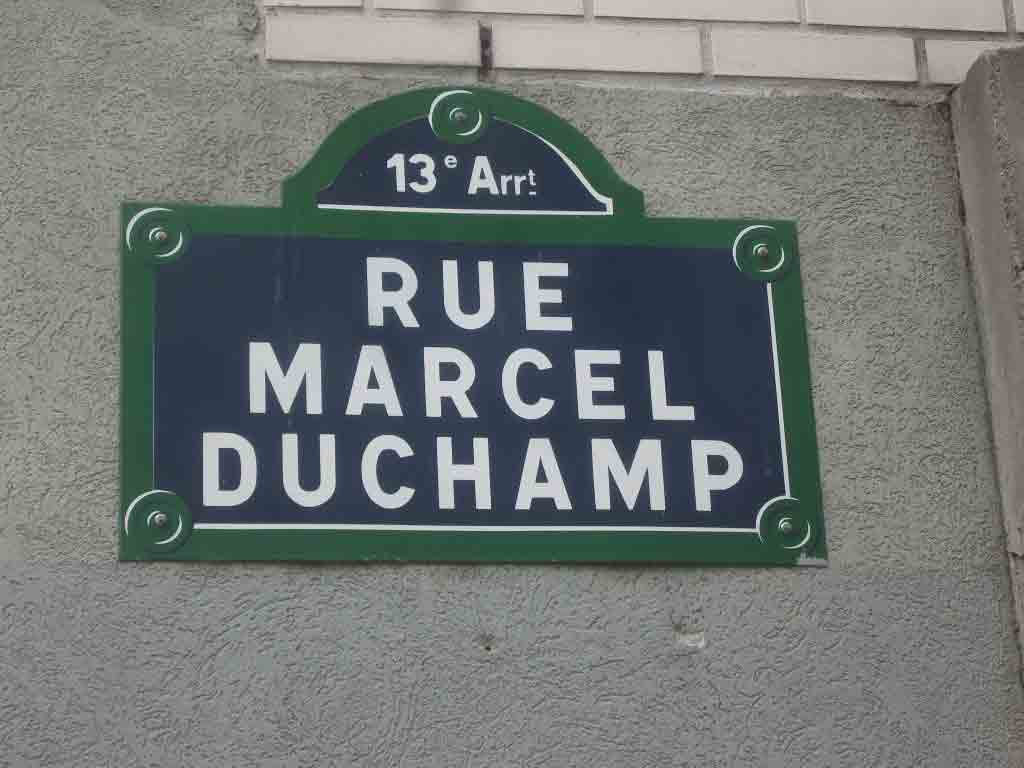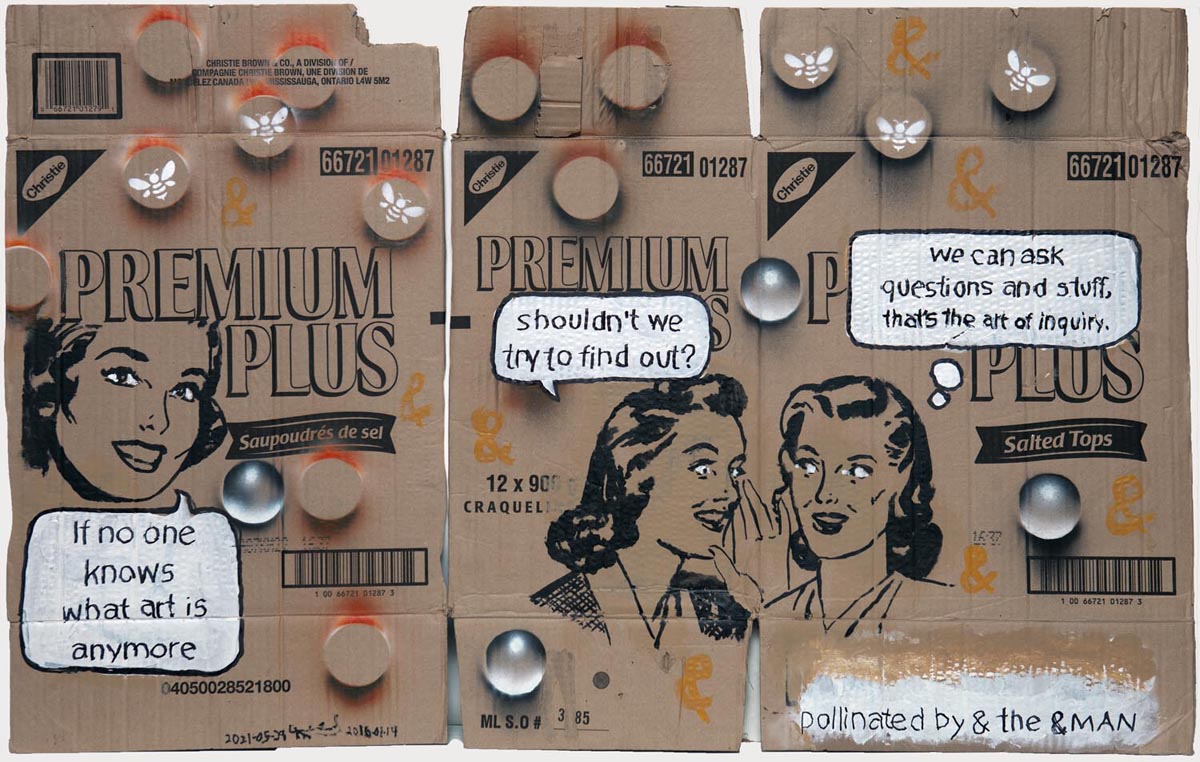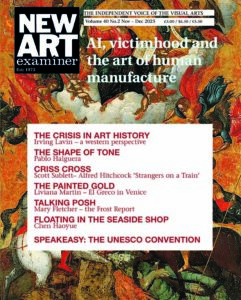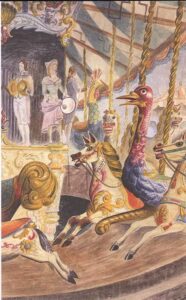
A Dismal Failure of Peer Review
Decolonizing Marcel Duchamp
by Miklos Legrady
As an artist the author must consider the political implications of art. A student of mine said that art has no real consequence, much like Duchamp who said that art is but a decoration for the living room wall. No such statements are realistic. Rather, political science suggests your culture is your future. Our current political climate tells us that when a political party bases its modus operand on lies and deception, the end results will be terrible. And when politics take such shape it is proceeded by a cultural ethos that promotes lies and a departure from the real and sensible, then it is culture that creates the politic that destroys the common good and promotes an evil treatment of people around us, such as is currently being celebrated under Donald Trump, MAGA, and Republicans. While many hope that such people can be undone in the near future, it is just as likely that Hitler’s concentration camps, will reappear in Florida. It is time we consider that possibility. Since art influences the public, and Duchamp’s urinal told the public that it is ok to piss on art, our highest values, and that art is anything you can get away with, we reassured the public that politics is also anything you can get away with. We told the world that morality and values are meaningless. Duchamp’s urinal and Cattelan’s banana elected Donald Trump.
As a youth the author became aware that the art theory and philosophy shaping the end of the 20th century and start of the 21st were based on logical failures, promoted by vested interests, The author then studied the historical documents and compare them to the art history we’re taught in schools. Exposing the differences, the irresponsibility and failure of integrity, well, that might lead to a different culture and future. And so came the text Did DADA create MAGA? When DADA said that art was anything that Duchamp could get away with, MAGA was justified in claiming that politics was anything that Donald Trump could get away with.
The author presented some of his conclusions to a credible academic art journal, whose editor sent it out for peer review. In the paragraphs below we find both the author’s text and the reviewer’s comments rejecting this proposed article titled TheMalfeasance of Marcel Duchamp. The author believes the title may have triggered the reviewer, who perhaps found comfort in the status quo, while this article shook the tree and challenged the familiar

That is why Kitty Scott, a curator at the National Gallery of Canada, wrote on Facebook a few years ago that no one knows what art is anymore. The author put his nose to the grindstone and learned that art is a value judgment. This attempt to clean up and save postmodernism displeased many. Here’s what caused the latest ruckus.
The Malfeasance of Marcel Duchamp
Extraordinary claims require extraordinary evidence, so when we claim Duchamp lacked an understanding of art, and that that the art world adopted a sacrificium intellectus to maintain the Duchamp myth, we certainly need substantial evidence. Such evidence exists, we have the receipts.
There is a 1968 video currently on youtube, https://youtu.be/Zo3qoyVk0GU, where Joan Bakewell’s BBC interview of Marcel Duchamp, Duchamp says he sought to discredit art; art is unnecessary; we should get rid of it the way some got rid of religion. His colleague Picabia wrote that art was the opiate of idiots. Why did Duchamp and Picabia say such silly things? One suspects because they were Dadaists who aim to shock the bourgeoisie.
Then comes the sacrificium intellectus. On viewing a copy of the full length video on line, we find that the above segment, at 17:24/27:09, has been deleted from the only complete copy available. This copy was censored and then uploaded by curator Francesca Seravalle. She writes “Interpreting an archive is a matter of patience and intuition, it is above all asking the right questions. It’s about activating a collective memory.” I email Ms. Seravalle asking the right question; “why was that section deleted? But she did not reply. Perhaps it does not match the collective memory, support the Duchamp myth. It becomes obvious Duchamp did not understand visual art was a visual language, that a picture was worth a thousand words. Perhaps the science was not yet common knowledge in his time.
Robert Motherwell wrote that “Duchamp was the great saboteur, the relentless enemy of painterly painting… His disdain for sensual painting was… intense.” When Pierre Cabane asked where his anti-retinal attitude comes from, Duchamp replied “from too great importance given to the retina. Since Courbet, it’s been believed that painting is addressed to the retina. That was everyone’s error… It has to change...”
We’d be surprised if Shakespeare despised consonants and diphthongs, if Leonard Cohen scorned guitar strings, if Misty Copeland (American Ballet Theatre) or Karen Kain (National Ballet of Canada) spurned the pirouette and grand jeté.
Duchamp’s wish to turn painting into an illustration of ideas degrades the medium. It’s obvious Duchamp isn’t aware of visual language, which expresses what cannot be said with words. Non-verbal languages include body language, whose formal expression is dance; acoustic language, whose formal expression is music and audio works; and visual language, where a picture is worth a thousand words. On Pierre Cabane asking if easel painting is dead Duchamp replies “it’s dead for the moment, and for a good hundred and fifty years. Unless it comes back; one doesn’t know why, as there’s no good reason for it”.
That said, the long awaited ‘death of painting’ is an unrealistic expectation. The science of non-verbal discourse dates back to Charles Darwin’s 1872 publication on the expression of emotions in humans and animals. Kevin Zeng Hu at MIT Media Lab writes “we all know how unwieldy texting can be and how much context can be lost, especially emotional context. Once you make it visual, you have a higher bandwidth to convey nuance. Such science confirms that painting and literature offer different kinds of notation in use ever since calligraphy split off from pictography. Thus painting cannot die anymore than literature, or dance, or music; they all have their place as different forms of thinking, expression, and communication.
The Duchamp myth disintegrates further; the urinal was by Elsa von Freytag Loringhoven, as seen in a letter by Duchamp to his sister. “April II [1917] My dear Suzanne… one of my female friends under a masculine pseudonym, Richard Mutt, sent in a porcelain urinal as a sculpture.” Duchamp also insisted Found Objects are not art: “The word ‘readymade’ thrusts itself on me then. It seemed perfect for these things that weren’t works of art, that weren’t sketches, and to which no term of art applies.”
With readymades, Duchamp decided that art was about having ideas, in advance of Sol Lewitt. That is wrong. Many have ideas but few have the ability to realize them. It does look like Duchamp failed to understand art, and the art world failed to understand Duchamp. Instead they graded him on a curve. No one who understands art would say we should get rid of it, and Duchamp paid the price. For saying that art was unnecessary and we should get rid of it, because of his effort to discredit art, he lost his motivation and could no longer be an artist, something he regretted. In Pierre Cabane’s “Dialogues with Marcel Duchamp”, Duchamp had already told Jasper Johns he didn’t mean to do it, didn’t mean to stop making art, he couldn’t make art anymore, it was like a broken leg. In effect, Duchamp’s DADA attitude and the works he made to discredit art destroyed him. He retired to play chess, which is the least creative and most intellectual activity. End of author’s article.
The peer review of Malfeasance of Marcel Duchamp
Duchamp is far from flawless. Some people might even find certain of his works puerile. Yet there is no doubt that he was a highly accomplished artist.
The author clearly has a fixation on painting as the most highly valuable art medium, a sacred cow that Duchamp helped to slaughter–thank goodness! In a certain sense, painting has never recovered from Duchamp’s assault in the form of his rectified readymade, L.H.O.O.Q. (1919). Yet before Duchamp abandoned painting, he had demonstrated his own unquestionable skill in that medium early in his career.
The fact that Duchamp abandoned painting does not invalidate his art in the other media he subsequently adopted. His use of glass, paper, all manner of found objects, and string (I think of Mile of String, 1942) is is highly original. Neither does the fact that he subsequently more or less abandoned art of any kind for chess in his last years discredit that art in a variety of media. Much of Duchamp’s work, from the readymades in the nineteen-teens to the monumental late Étant donnés, completed in 1966, is not merely provocative but innovative and deeply thought provoking if one abandons the idea that art, to be of value, must be painted.
Only one claim that the author makes–that Duchamp was (at least for part of his career) affiliated with Dada and liked to shock–is sensible, but scarcely original. To shock was a perfectly viable–and reliable–strategy adopted by Dada artists that gave rise to some excellent artworks, including many by Duchamp himself. I think of, among others, his extraordinary transgender productions as Rrose Sélavy (yes, that’s the correct spelling–sound it out in French).
There is a double irony in Duchamp’s work that some find disingenuous: he could produce art and statements in his publications in line with the principle “always bite the hand that feeds you,” while working with commercial interests (for instance, the dealer Arturo Schwartz in the 1960s) to capitalize on his earlier achievements. That Duchamp seemingly relinquished art in his last years in no way discredits his extraordinary inventiveness. Duchamp’s oeuvre may be flawed in certain respects, and he himself may have been too clever by half, but this Short Note submission is itself too deeply flawed to accept for publication.
____________________
Now, a few comments by the author. Writers must meet some standards. First they must be accurate, then they must be logical and relevant, and third their work should be well written in order to be interesting. The peer review fails to meet any of those standards and in its boredom would drag down this entire article, so it has been left to the end as a reference. The peer reviewer strangely accused the author of being obsessed with painting, writing that “The author clearly has a fixation on painting as the most highly valuable art medium, a sacred cow that Duchamp helped to slaughter – thank goodness”
Nowhere in the author’s short note does it say painting is the most important medium. In fact the opposite is quite clear in the statement “Thus painting cannot die anymore than literature, or dance, or music; they all have their place as different forms of thinking, expression, and communication”. The nature of projection is evident here; it is likely the peer reviewer who has a fixation, writing that painting is a “sacred cow” Duchamp helped destroy, “thank goodness”. Such a dislike of what is simply another art medium is better address by a psychiatrist. The peer reviewer then added an unrealistic and irrational comment revealing their failure to understand the nature of any media. “In a certain sense, painting has never recovered from Duchamp’s assault in the form of his rectified readymade, L.H.O.O.Q. (1919).” This refers to Duchamp painting a moustache on the Mona Lisa; the peer reviewer assuming painting could never recovered from this “earth shattering” event. The peer reviewer then attempted to prove the author’s critique was mistaken by including a list of Duchamp’s work, trusting in the magical spell of naming titles without further explanation, and end with “therefore I cannot recommend publication of this short note.”
The author contacted the journal’s editor pointing out how ridiculous the peer review was, suggesting changing the title so as not to trigger conservatives, and resubmit the article to a different review. The editor replied that the peer reviewer was a well established and highly respected art historian and refused to consider any further steps. It was obvious the editor had not read the author’s text nor taken a moment to examine the peer reviewer’s flawed response, thus shirking their own responsibilities. Equally obvious, the reviewer did not attain their position by the quality of their scholarship. Some reach great acclaim lacking any talent but for their gift at climbing the social ladder.
It took some time before realizing the peer reviewer was likely affiliated with the same institution as the editor, who was likely covering up for a colleague’s malfeasance and scholastic failure. Within an internal dialogue The author thanked the editor for providing him with so graphical example of corruption, just as the author would ask the editor how they could allow them self to continue in their post? What lofty aspirations are they betraying? Had a graduate student written that review they would quickly be sent to the relevant documentation, the historical evidence and the modern science that would correct such ignorance. We now have an answer to how the corruption of art history and the cultural canon occur, and why it is so hard to do anything about it. Understanding this phenomenon is, according to the late Roger Scrutton,, integral to understanding how a high culture works, and how it can become corrupted.
We now recognize how the art world may well bear a large share of responsibility for the rise of MAGA. The lies and delusions that art is anything you can get away with may well have led the public to join MAGA in saying that politics is anything that Donald Trump can get away with. Your culture is your future.
Max Planck wrote that science advances one funeral at a time. Or more precisely: “A new scientific truth does not triumph by convincing its opponents and making them see the light, but rather because its opponents eventually die, and a new generation grows up that is familiar with it” If we have not seen as far as others, likely we were standing on the shoulders of very short giants, else the giants were standing on our shoulders.

